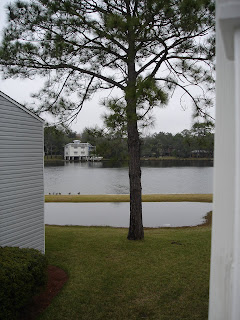 We've had some requests for pictures of our apartment, so we thought we'd indulge. It's a teeny little place, but it's affordable and we've really grown to love it--especially being so near the water. We hope these photos give you a good idea of what it's like, inside and out. And we hope as many of you can see it in person as possible. Until then...enjoy!
We've had some requests for pictures of our apartment, so we thought we'd indulge. It's a teeny little place, but it's affordable and we've really grown to love it--especially being so near the water. We hope these photos give you a good idea of what it's like, inside and out. And we hope as many of you can see it in person as possible. Until then...enjoy!First things first...Our "water view."

We know, it's just a sliver, but it's still nice to walk out our front door, or look through our bedroom window and see the sunlight sparkling on the water. This is actually the Choctawhatchee Bay, not the Gulf.

This little inlet from the bay is on the East side of our apartment. The picture is taken from our balcony. (We commonly see Belted Kingfishers, Osprey, Common Loons, Horned Grebes, Double-crested Cormorants, Laughing Gulls, Ring-billed Gulls, and Brown Pelicans in this inlet-KJ)

This is our living room. The bookshelves along the wall were here when we moved in...we supplied the books! :) (And Christmas lights!)

The reading nook.

Looking at the dining area from the living area. We have a vaulted ceiling with a skylight, which is pretty cool, although you can't see it in this picture. We recently re-upholstered the dining chairs, and we were super happy to find a rug that matched the new colors perfectly!

Our teeny tiny little kitchen. One nice thing, which you can't see from this photo, is that the right side of the kitchen opens into the living area, so it's easy to be working in the kitchen and conversing with people in the living room.
It wouldn't be Florida without beautiful sunsets. This series of photos was taken in a half-hour time span on the bay just out from our apartment.







































.JPG)



.JPG)

